Pashmina, often famous as the "king of fibers," is one of those art forms that people have cherished for centuries. Legend has it that Emperor Akbar, one of India's greatest rulers, valued the luxurious softness of Pashmina. As a result, he gifted Pashmina shawls to dignitaries worldwide as symbols of his empire's opulence and craftsmanship. This anecdote underscores the timeless allure and unmatched quality of Pashmina. And indeed, this art continues to captivate hearts and wardrobes globally.
As such, it becomes a prerequisite for us to delve deep into the essence of 100% Pashmina. So, we will be exploring its unique composition and understand what makes it such a coveted material. Pashmina is the art of producing luxury goods from Cashmere wool. Cashmere comes from the fine undercoat of the Changthangi goats found in the high-altitude regions of the Himalayas. The delicate Cashmere fiber undergoes a meticulous process from collection to the creation of luxurious shawls and garments. Each piece hence produced is a testament to unparalleled craftsmanship. Understanding the makeup of 100% Pashmina is crucial for appreciating its softness, warmth, and durability. After all, these qualities set it apart from wool, silk, or synthetics.
This blog will cover several key areas to provide a comprehensive understanding of 100% Pashmina. We will begin with its origins, tracing the journey of Pashmina from the Changthangi goats to the finished product. Then, we will explore the characteristics that make Pashmina unique, including its fineness, warmth, and breathability. We will also discuss the cultural and economic significance of Pashmina, particularly in the regions where goats produce it. Finally, we will offer guidance on how to identify genuine Pashmina, ensuring you can distinguish it from imitations, and make informed purchasing decisions.
The Source: Changthangi Goats and collecting Cashmere
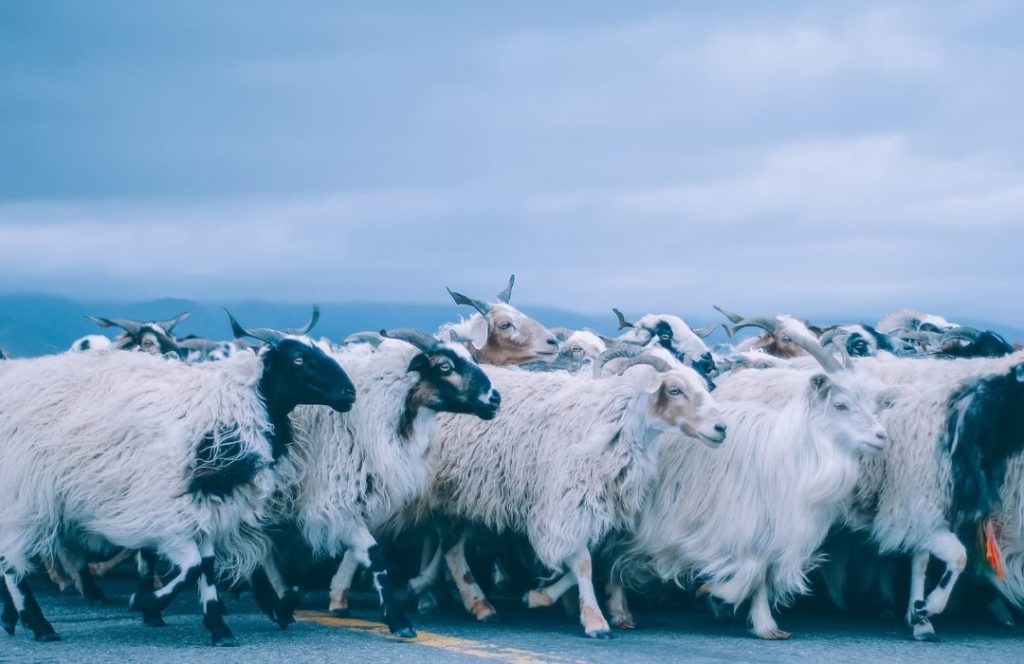
The story of Pashmina begins in the remote, high-altitude regions of Ladakh. Here, the Changthangi goats, also known as Pashmina goats, reside. These remarkable animals are the sole source of the precious Pashmina wool. Adapted to the harsh, cold environment of the Himalayas, the Changthangi goats possess a unique undercoat. This undercoat provides the raw material for Pashmina. Understanding the origin and collection of this wool sheds light on why 100% Pashmina is so special.
The Changthangi goats thrive in the extreme conditions of the Changthang plateau, a part of the greater Tibetan Plateau in the Indian-administered region of Ladakh. This area is characterized by its rugged terrain, sparse vegetation, and temperatures that can plummet to -40°C in winter. The goats have evolved to withstand these conditions, developing a double-layered coat. The outer layer consists of long, coarse guard hairs that protect against the elements. On the contrary, the inner layer is composed of fine, soft fibers that provide insulation against the cold. It is this inner layer, the precious undercoat, that is used to produce Pashmina.
Process of collecting Cashmere
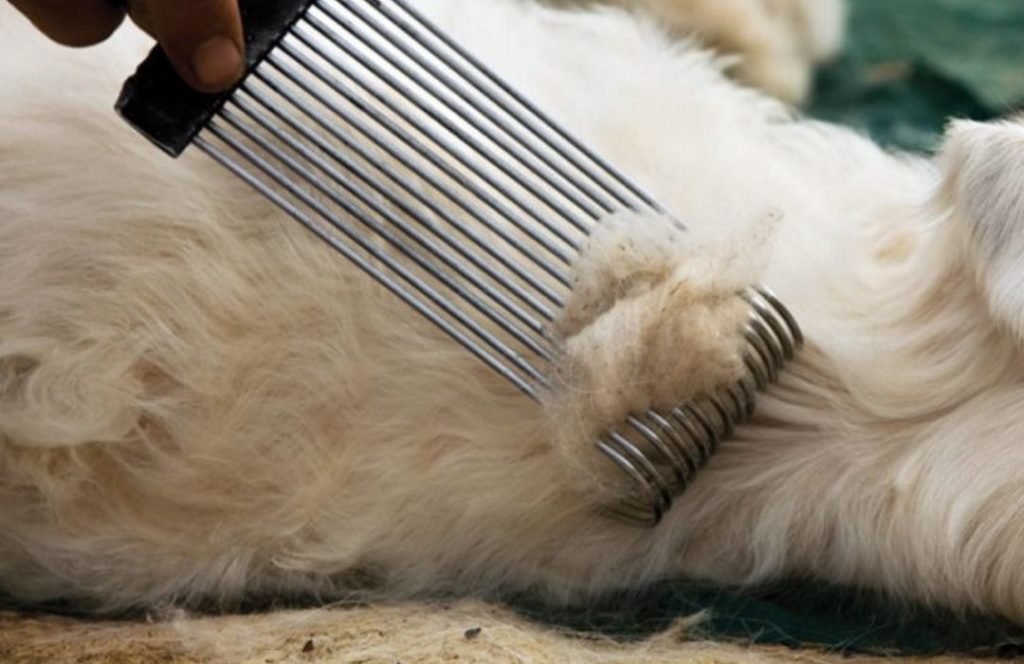
The process of collecting Cashmere wool is a labor-intensive and time-consuming task. Herders typically carry this task out in the spring when the goats naturally shed their winter coats. Herders carefully comb the goats by hand to collect the fine undercoat. This method ensures that the animals are not harmed and that the wool is gathered in the most efficient manner. Each goat produces only about 80-170 grams of Cashmere wool per year. This fact highlights the rarity and value of this fiber.
The combing process itself is an art form, requiring skill and patience. Herders use special combs to gently separate the fine undercoat from the coarse outer hairs. Herders then sort and clean the collected wool to remove any impurities. This initial stage of processing is crucial, as it ensures the purity and quality of the Cashmere wool. Unlike other fibers, the wool does not undergo harsh chemical treatments, preserving its natural softness and luster.
After herders collect Cashmere, it undergoes a meticulous hand-spinning process and transform it into yarn. This traditional method, passed down through generations, involves spinning the wool on a charkha (spinning wheel) to create fine threads. The hand-spinning technique is vital in maintaining the integrity and softness of the fiber, distinguishing genuine Pashmina from machine-made imitations.
What makes Pashmina special?
The habitat and living conditions of the Changthangi goats, combined with the painstaking process of wool collection, underscore the exceptional quality of 100% Pashmina. The unique environment in which these goats live contributes to the fineness of the fibers. As a result, the fibres are much softer and warmer than regular sheep’s wool. The high-altitude conditions ensure that the wool has superior insulating properties, making Pashmina shawls incredibly warm yet lightweight.
The source material of 100% Pashmina is a testament to nature’s ingenuity and the dedication of the herders. Note that herders have managed to maintain this age-old tradition. The Changthangi goats, with their remarkable adaptation to the Himalayan climate, provide Cashmere. Later, artisans carefully comb and process this wool by hand. This combination of natural beauty and human craftsmanship results in a fiber that is not only luxurious but also deeply rooted in the cultural heritage of Ladakh. Understanding the origins of Cashmere wool and the meticulous process of its collection allows us to truly appreciate the value and uniqueness of 100% Pashmina.
The Production process - From Cashmere to Pashmina
The journey of 100% Pashmina from raw fiber to exquisite shawl is a labor of love and intricate craftsmanship, involving several meticulous steps. This section delves into the traditional methods of spinning Cashmere yarn, the weaving techniques employed to create luxurious Pashmina shawls/scarves, and the dyeing process that adds vibrant colors while preserving the natural qualities of the fiber.
Spinning Cashmere Yarn
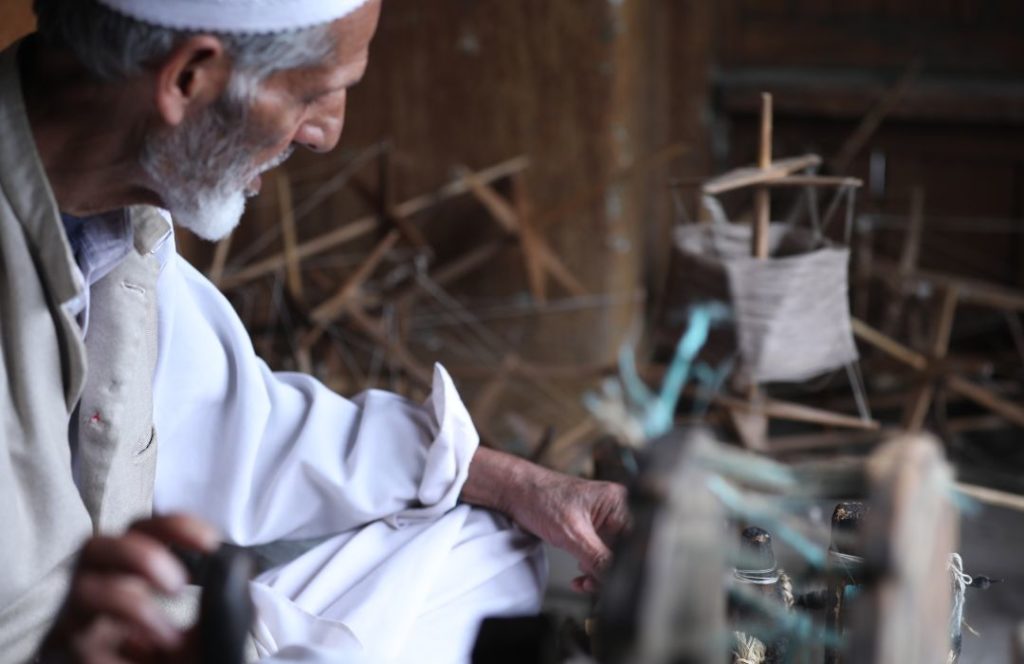
The spinning of Cashmere yarn is a delicate and time-consuming process that requires exceptional skill. This traditional method, often carried out by experienced artisans, ensures that the inherent softness and fineness of the wool are maintained. The process begins with the cleaned and sorted wool, which is carefully hand-spun using a charkha, a traditional spinning wheel. The artisan's skill lies in their ability to spin the wool into extremely fine threads, typically measuring between 10 to 15 microns in diameter.
Hand-spinning is crucial for several reasons. It maintains the length and integrity of the fibers, which is essential for the softness and strength of the finished product. Unlike machine-spun yarn, hand-spun Cashmere retains its natural elasticity and luster. This process also allows artisans to produce threads of varying thickness, depending on the desired outcome of the final product, whether it be a lightweight shawl or a thicker, warmer piece.
Weaving Techniques
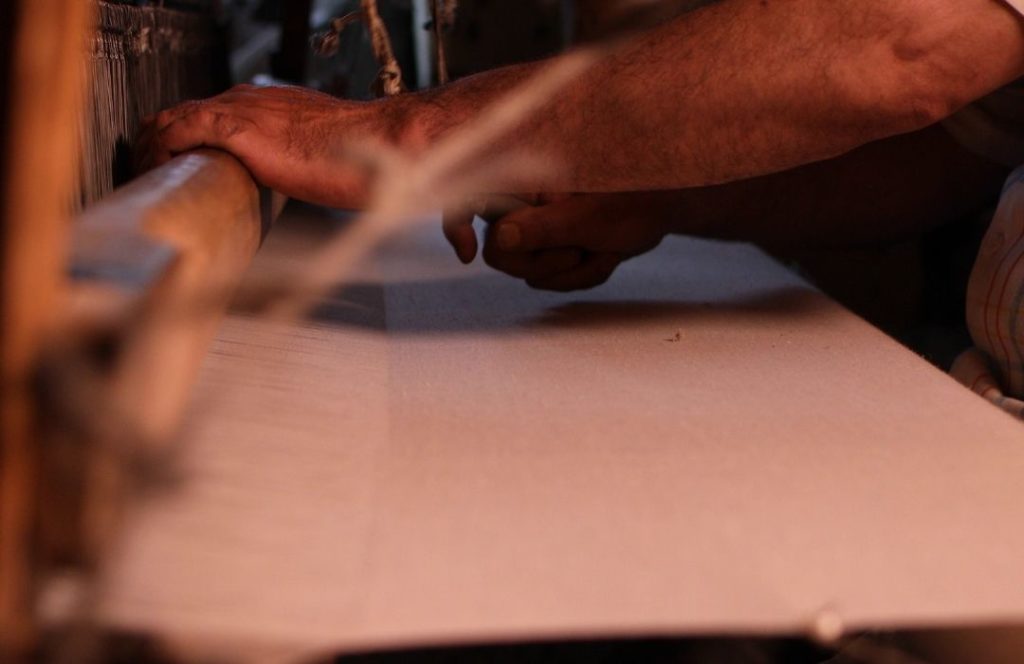
Once artisans spin the yarn, they get it ready for the weavers. The weaving of Pashmina is a traditional craft that has come down through generations, particularly in the Kashmir Valley. The region's artisans are famous for their expertise in creating intricate patterns and designs that are both beautiful and functional.
The weaving process takes place on handlooms, which require the artisan to have a keen eye for detail and a steady hand. Each Pashmina shawl can take several weeks to months to complete, depending on the complexity of the design. Weavers set up the loom with the warp threads, which they stretch vertically. The artisan then weaves the weft threads horizontally, interlacing them with the warp to create the fabric. This method, known as the twill weave, gives Pashmina its characteristic diagonal rib pattern, adding to its durability and drape.
Kashmiri weavers often incorporate intricate motifs and patterns into their work, using techniques such as kani weaving and jacquard weaving. Kani weaving involves the use of small wooden sticks (kani) to interlace different coloured threads, creating elaborate and colourful designs. Jacquard weaving, on the other hand, uses a specialized loom to produce detailed and complex patterns. These traditional techniques highlight the artisans' skill and creativity, making each Pashmina item a unique work of art.
Dyeing Process
The final step in the production of Pashmina is the dyeing process, which brings vibrant colors to the natural cream or white wool. Specialist dyers employ traditional dyeing methods to preserve the natural qualities of Pashmina while adding rich hues to the fabric.
Dyers prefer natural dyes for dyeing Pashmina, as they are gentle on the fibers and environmentally friendly. These dyes come from plant materials, minerals, and other natural sources. Common natural dyes include indigo for blues, madder root for reds, and turmeric for yellows. The use of natural dyes not only enhances the aesthetic appeal of Pashmina but also aligns with sustainable and eco-friendly practices.
The dyeing process begins with the preparation of the dye bath. Dyers boil the dye materials in water to extract their colourants, creating a concentrated dye solution. They then immerse the fiber in the dye bath, and stir it gently to ensure even absorption of the dye. Dyers control the temperature and duration of the dyeing process carefully to achieve the desired shade and intensity of colour.
After dyeing, Dyers thoroughly rinse the fiber to remove any excess dye and then dry it in the shade to prevent fading. The result is a range of beautiful, colourful Pashmina shawls, scarves, and wraps. Each has a unique hue and vibrancy that complements the natural softness and luster of the fiber.
Hence, the production process of 100% Pashmina is a testament to the artistry and dedication of the artisans who create these luxurious items. From the hand-spinning of the yarn to the intricate weaving techniques and the careful dyeing process, every step is carried out with precision and care. This meticulous craftsmanship ensures that Pashmina retains its unique qualities of softness, fineness, warmth, and durability, making it a cherished and timeless addition to any wardrobe.
Characteristics of 100% Pashmina: Unraveling Its Unique Attributes
When asking "What is 100% Pashmina made of?", it's essential to delve into the specific characteristics that distinguish this luxurious fabric from other natural fibers. Known for its unparalleled softness, fineness, and warmth, Pashmina stands out in the realm of high-quality textiles. This section explores the physical attributes of Pashmina fibers, compares them with other natural fibers such as wool and silk, and highlights the unique qualities that make 100% Pashmina exceptionally special.
Physical Characteristics of Pashmina Fibers
Pashmina is renowned for its incredible softness, a result of the ultra-fine fibers sourced from the undercoat of the Changthangi goats. And, despite its lightweight nature, Pashmina offers remarkable warmth. Here are a few more physical characteristics of Pashmina that answer the question "what is 100% Pashmina made of"
1. Softness
- Micron Diameter: Pashmina fibers measure between 10-15 microns in diameter, much finer than traditional wool.
- Tactile Experience: The fine fibers contribute to an incredibly soft and smooth feel, making Pashmina exceptionally comfortable against the skin.
- Comparison with Wool: Traditional wool fibers are thicker (20-40 microns), making them feel heavier and sometimes itchy.
2. Fineness
- Fiber Composition: Derived from the undercoat of the Changthangi goats, known for producing some of the finest wool in the world.
- Lightweight Nature: Despite its warmth, Pashmina is lightweight, allowing for versatile use in various garment types.
- Weaving Quality: The fineness of the fibers allows for intricate and delicate weaving patterns, enhancing the aesthetic appeal of the final products.
3. Warmth
- Insulating Properties: Pashmina fibers have a natural ability to trap air, providing excellent insulation.
- Temperature Regulation: The breathability of Pashmina ensures comfort in both cold and mild climates, unlike wool which can be too warm.
- Layering Benefits: Its lightweight yet warm nature makes it ideal for layering without adding bulk.
4. Durability
- Longevity: Properly cared-for Pashmina items can last for many years, retaining their beauty and functionality.
- Strength of Fibers: Despite being fine, Pashmina fibers are strong and resilient, capable of withstanding regular use.
- Care Instructions: Requires gentle hand washing or dry cleaning, and careful storage to maintain quality.
5. Unique Artistry
- Handcrafted Excellence: Often hand-spun, woven, and embroidered, each Pashmina piece showcases intricate craftsmanship.
- Design Variety: Traditional and contemporary designs, reflecting cultural heritage and artistic expression.
- Individuality: Each Pashmina item is unique, often considered a work of art.
6. Breathability
- Moisture Management: Cashmere fibers naturally wick away moisture, keeping the wearer comfortable. Hence, patrons find it the best choice in winter.
- Versatile Use: Suitable for various climates, as it can keep the wearer warm in cold weather and cool in warmer conditions.
- Comfort Level: Breathability ensures that Pashmina is comfortable to wear for extended periods. Hence, it is ideal for those who are sensitive to temperature changes.
7. Texture and Feel
- Luxurious Feel: Known for its smooth texture, Pashmina feels gentle against the skin. As such, having a Pashmina shawl feels like a luxury.
- Non-Itchy: Unlike many wool products, Pashmina does not cause irritation or itchiness. Hence, it is best for those who are prone to allergies to fabric.
- Smoothness: The fine fibers result in a smooth and elegant finish. As Such, Pashmina shawls or scarves look regal and grand.
8. Colour and Dyeing
- Natural Dyes: Often dyed using natural, Pashmina carries eco-friendly dyes that do not compromise the softness of the fibers.
- Colour Retention: Pashmina retains dyes well, resulting in vibrant and lasting colours. On the contrary, many of their counterparts tend to lose colour after the first wash
- Customization: Wide range of colour options are available for Pashmina, suitable for various fashion preferences.
9. Thickness and Weight
- Thin Fibers: The thinness of the fibers contributes to the lightweight nature of Pashmina products. The Cashmere fiber is just 10 to 15 microns in thickness
- Comfortable Wear: Pashmina allows for comfortable wear without the bulkiness associated. For this reason, it is ideal for traveling.
Comparing Pashmina with other fibers
When comparing Pashmina with other fabrics, the supremacy of this grand art form comes to light. Here is a comparison of Pashmina with Silk and wool
Pashmina vs. Wool
When comparing Pashmina to regular wool, several distinctions become evident. Wool fibers are generally thicker, ranging from 20 to 40 microns in diameter, which makes wool garments feel heavier and sometimes itchy against the skin. Pashmina, with its finer fibers, offers a softer, more comfortable experience. Additionally, wool tends to be bulkier, whereas Pashmina maintains warmth without the added weight, making it a more versatile choice for layering and year-round use.
Pashmina vs. Silk
Silk is another luxurious natural fabric, known for its smooth, shiny texture. While both Pashmina and silk are soft and pleasant to touch, they provide different sensory experiences. Pashmina is warm and cozy, ideal for colder weather, while silk has a cool, slick feel, making it better suited for warmer climates. Silk is also more delicate and less insulating compared to Pashmina. When blended, these fabrics can create exquisite textiles that combine the best properties of each, enhancing the appeal of garments and accessories that incorporate both fibers.
Unique Qualities of Pashmina
Pashmina has a set of unique qualities that make it supreme and one of a kind. Here are a few of them:
Durability and Strength
One of the lesser-known attributes of 100% Pashmina is its durability. Despite the fineness of the fibers, Pashmina products are remarkably strong and long-lasting. Proper care, such as gentle hand washing and careful storage, can preserve the quality of Pashmina items for many years. This durability, combined with its softness and warmth, makes Pashmina a wise investment for anyone looking to add timeless pieces to their wardrobe.
Unique Artistry
What is 100% Pashmina made of if not centuries of tradition and craftsmanship? The intricate artistry involved in creating Pashmina products is a testament to the skill and dedication of the artisans. Each piece is often hand-spun, woven, and then embroidered, resulting in unique designs that reflect cultural heritage and individual creativity. This artistry not only adds to the aesthetic appeal of Pashmina but also ensures that each item is a unique work of art.
Cultural Significance
Pashmina holds significant cultural importance in the regions where it is produced, particularly in Kashmir. It is often considered a symbol of luxury and status, traditionally worn during important ceremonies and gifted on special occasions. The cultural reverence for Pashmina adds to its allure as a luxury item, making it not only a fashion statement but also a piece of cultural heritage.
Economic Importance
The Pashmina industry plays a vital role in the economies of regions like Kashmir and Ladakh, providing employment to many artisans and herders. The high value of Pashmina products on the international market contributes significantly to local economies, supporting entire communities. This economic importance underscores the need to promote and sustain the Pashmina industry, ensuring that the traditions and livelihoods associated with it continue to thrive.
Hence, understanding "What is 100% Pashmina made of" involves appreciating its unique characteristics, including its softness, fineness, warmth, and durability. When compared to other natural fibers like wool and silk, Pashmina stands out for its exceptional qualities. Its cultural and economic significance further enhances its value, making 100% Pashmina a timeless and cherished material in the world of luxury textiles.
The Exquisite Craftsmanship: What makes Pashmina regal?
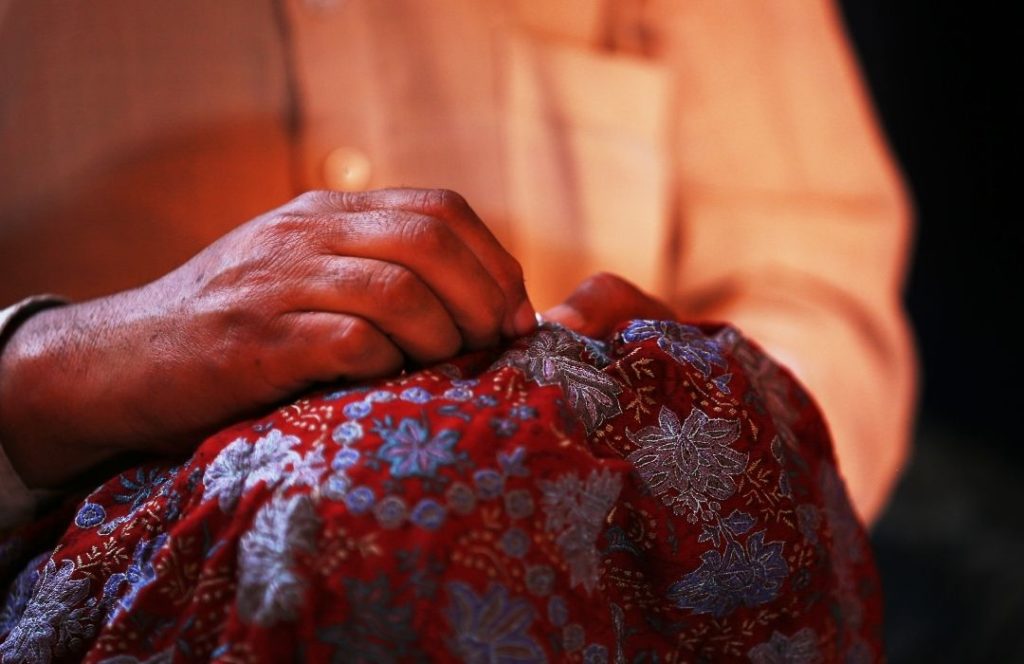
The production of Pashmina products is an art form that demands exceptional skill, patience, and dedication. The intricate craftsmanship involved in creating Pashmina shawls, scarves, and other items is a testament to the artisans' expertise and the time-honored techniques passed down through generations.
Skills and Techniques of the Artisans
The many meticulous processes that convert Cashmere to luxury Pashmina products are carried out by Kashmiri artisans. These processes are painstaking and require immense skill. Here is the journey of a Pashmina shawl or scarf, from Cashmere to the final product:
Spinning
The process begins with spinning the raw Cashmere wool into fine yarn. This delicate task requires a steady hand and a keen eye for detail. Traditional spinning wheels, known as "yander" in the local language, are used to spin the fibers into yarn. Artisans must ensure that the yarn is consistently even and fine, which is crucial for the quality of the final product.
Weaving
Weaving is perhaps the most intricate part of the Pashmina production process. Artisans use handlooms to weave the spun yarn into fabric. The weaving technique is a complex interplay of warp and weft threads, creating a tightly woven yet lightweight and breathable fabric. Hence, master weavers, often with decades of experience, meticulously interlace the threads, ensuring that the fabric is uniform and free from defects.
Embroidery
Many Pashmina shawls are adorned with exquisite embroidery, adding a layer of artistry and cultural significance to the product. Techniques such as Sozni, Tilla, and Aari embroidery are employed to create intricate patterns and designs. Each type of embroidery has its own unique style and requires a different set of skills:
- Sozni Embroidery: This involves detailed needlework, often depicting floral motifs and paisleys. It is a labor-intensive process, with artisans spending weeks or even months on a single shawl.
- Tilla Embroidery: Tilla's work involves the use of metallic threads to create elaborate designs, adding a touch of opulence to the shawl.
- Paper Mache Embroidery: This work is done using a needle to create thicker patterns, often covering large areas of the fabric with intricate designs.
Dyeing
The dyeing process adds color to the fabric. Traditionally, natural dyes derived from plants, minerals, and other natural sources are used. The dyeing process must be carefully controlled to ensure that the colors are vibrant and evenly distributed. Artisans often use traditional methods to prepare the dyes and apply them to the fabric, ensuring that the colors are both beautiful and long-lasting.
Time and Effort Required
Creating high-quality Pashmina items is a time-consuming process that involves several stages, each requiring meticulous attention to detail:
- Collection and Preparation: The process begins with the collection of raw wool from the Changthangi goats. The wool is then cleaned and sorted to remove any impurities.
- Spinning: Turning the raw wool into fine yarn can take several days, depending on the desired fineness and quality of the yarn.
- Weaving: Weaving a single Pashmina shawl can take anywhere from a few days to several weeks, depending on the complexity of the design and the skill of the weaver.
- Embroidery: Embroidered shawls require additional time, with artisans sometimes spending months on a single piece to achieve the desired level of detail and intricacy.
- Finishing: After weaving and embroidery, the shawls undergo a finishing process that includes washing, stretching, and ironing to enhance the softness and appearance of the fabric.
The Artisans' Dedication
The artisans involved in Pashmina production are deeply dedicated to their craft. Many come from families that have been practicing these techniques for generations. Their commitment to preserving traditional methods while adapting to modern demands is evident in the quality and beauty of the Pashmina products they create. Each piece is a labor of love, reflecting the artisans' pride in their heritage and their passion for their work.
Hence, the craftsmanship involved in producing Pashmina products is a blend of skill, tradition, and artistry. The time and effort invested by the artisans ensure that each Pashmina item is not only a piece of luxury but also a testament to the rich cultural heritage and craftsmanship of the regions where it is produced. The dedication to maintaining high standards and preserving traditional techniques makes Pashmina truly special.
Economic and Cultural Importance
Economic Impact on Local Communities
The Pashmina industry is a vital economic pillar for communities in Kashmir and Ladakh. It provides employment and sustains the livelihoods of thousands of artisans, herders, and traders. The Changthangi goats, native to the high-altitude regions of Ladakh, produce the fine undercoat wool used for Pashmina. Herders play a crucial role in this industry by caring for these goats and harvesting the wool, which is a labor-intensive process requiring specific skills and knowledge.
The economic benefits extend beyond the herders. The raw wool undergoes several stages of processing, including cleaning, spinning, dyeing, weaving, and sometimes embroidery, before becoming a finished Pashmina product. Each stage offers job opportunities for local artisans, many of whom have honed their skills over generations. These artisans rely on the trade of Pashmina products for their livelihood, and the high value of these items on the international market significantly boosts the local economy.
Additionally, the export of Pashmina shawls and other products brings in foreign revenue, which can be reinvested in community development and infrastructure. Cooperatives and small businesses centered around Pashmina production contribute to economic stability and growth in these remote areas, helping to preserve traditional crafts while adapting to modern market demands.
Cultural Importance in Kashmir and Ladakh
Pashmina holds profound cultural significance in Kashmir and Ladakh. In these regions, Pashmina shawls are more than mere garments; they are symbols of heritage, status, and artistic expression. Traditionally, Pashmina shawls are worn during significant life events such as weddings, festivals, and religious ceremonies, symbolizing warmth, protection, and cultural identity.
The intricate patterns and motifs found in Pashmina shawls often tell stories of the region’s history and traditions. Artisans incorporate local folklore, natural scenery, and cultural symbols into their designs, making each piece a unique work of art. This cultural narrative embedded in the fabric elevates Pashmina from a mere fashion item to a cherished heirloom, often passed down through generations.
In the context of Ladakh, Pashmina also plays a role in social rituals and customs. The process of creating a Pashmina shawl, from shearing the goats to weaving the final product, is interwoven with the region's way of life. This deep connection to cultural heritage and traditional practices enhances the intrinsic value of Pashmina products for the local communities.
Role in Traditional and Modern Fashion
Pashmina has seamlessly transitioned from traditional to modern fashion, maintaining its status as a luxury item while adapting to contemporary trends. Historically, Pashmina shawls were worn by royalty and the elite, symbolizing luxury and sophistication. Today, Pashmina continues to be a staple in high fashion, favored by top designers and fashion houses worldwide.
In modern fashion, Pashmina is celebrated for its versatility and timeless appeal. It is used to create a variety of garments and accessories, including scarves, stoles, wraps, and even dresses. The fine, soft texture and natural warmth of Pashmina make it an ideal material for both winter wear and lightweight summer accessories. Designers often experiment with blending Pashmina with other fabrics like silk to enhance its drape and luster, expanding its applications in fashion.
Moreover, the sustainability aspect of Pashmina is increasingly appealing to eco-conscious consumers. As a natural and biodegradable material, Pashmina aligns with the growing demand for environmentally friendly fashion. The use of traditional, eco-friendly dyeing and weaving techniques further adds to its appeal in the sustainable fashion market.
The economic and cultural importance of Pashmina in Kashmir and Ladakh cannot be overstated. It supports local economies, preserves cultural heritage, and continues to influence both traditional and modern fashion. The enduring legacy of Pashmina, combined with its adaptability and sustainable qualities, ensures its place as a cherished and valuable textile in the global market.
Identifying Authentic Pashmina
Tips for Identifying Genuine 100% Pashmina Products
Identifying genuine 100% Pashmina can be challenging due to the prevalence of imitations in the market. Here are some tips to help distinguish authentic Pashmina from counterfeit products:
- Feel and Texture: Authentic Pashmina is incredibly soft and luxurious to the touch. It has a distinctive smoothness and warmth that synthetic fibers cannot replicate. When you rub it against your skin, it should feel gentle and not cause any irritation.
- Fiber Diameter: The fibers of genuine Pashmina are very fine, typically measuring between 10-15 microns in diameter. If you have access to a microscope, you can compare the fiber thickness to that of regular wool, which is coarser.
- Weave and Craftsmanship: Genuine Pashmina products often feature intricate irregular weaving patterns that reflect the artisan's skill. Look for irregularity in the weave and attention to detail in the embroidery. Regular weave or machine-like precision might indicate a fake product.
- Burn Test: If you are able to safely conduct a small burn test on a loose fiber, authentic Pashmina will smell like burnt hair, and the ash will be powdery. Synthetic fibers, on the other hand, will smell like burnt plastic and form hard beads.
- Lightness and Warmth: Genuine Pashmina is exceptionally lightweight yet provides excellent warmth. When draped over your shoulders, it should feel light but insulating.
- Price: While not a definitive factor, the price can be an indicator. Genuine Pashmina is expensive due to the labor-intensive process and the quality of the material. If the price seems too good to be true, it likely is.
Common Imitations and How to Avoid Them
The market is flooded with imitations that try to pass off as Pashmina. Here are some common types and how to avoid them:
- Viscose and Polyester Blends: These are the most common substitutes. They might look similar but lack the softness and warmth of real Pashmina. Always check the fiber content label and avoid products listed as "Pashmina blends" without specifying the percentage of Pashmina.
- Acrylic Wool: Some products are made from acrylic wool, which is cheaper and lacks the insulating properties of Pashmina. Conduct a burn test if possible, as acrylic will produce a different burn result compared to natural fibers.
- Fake Certification: Be wary of fake certification tags. Authentic Pashmina products often come with a certification from a recognized body, such as the Kashmir Pashmina Organization (KPO) or Craft Development Institute (CDI). Verify the authenticity of these certifications through the certifying body's website.
Importance of Certification and Quality Standards
Certification and adherence to quality standards are crucial in ensuring you are purchasing genuine Pashmina. Here’s why they matter:
- Guarantee of Authenticity: Certification from recognized bodies assures that the product is made from genuine Pashmina fibers and meets the quality standards of traditional craftsmanship.
- Ethical Practices: Certified Pashmina products are more likely to adhere to ethical practices in their production. This includes fair wages for artisans, sustainable harvesting of wool, and environmentally friendly dyeing processes.
- Consumer Confidence: A certification provides peace of mind to consumers, ensuring that they are investing in a high-quality, genuine product. It also helps in distinguishing authentic products from the plethora of counterfeits in the market.
- Preservation of Craftsmanship: By supporting certified products, consumers contribute to the preservation of traditional Pashmina craftsmanship. This helps maintain the heritage and skills passed down through generations.
Hence, identifying authentic Pashmina requires careful attention to the material's unique qualities, awareness of common imitations, and reliance on credible certifications. Understanding these aspects not only helps in making informed purchases but also supports the artisans and communities dedicated to producing this exquisite textile.
Also read: 9 surprising facts about Kashmiri Shawls
Conclusion
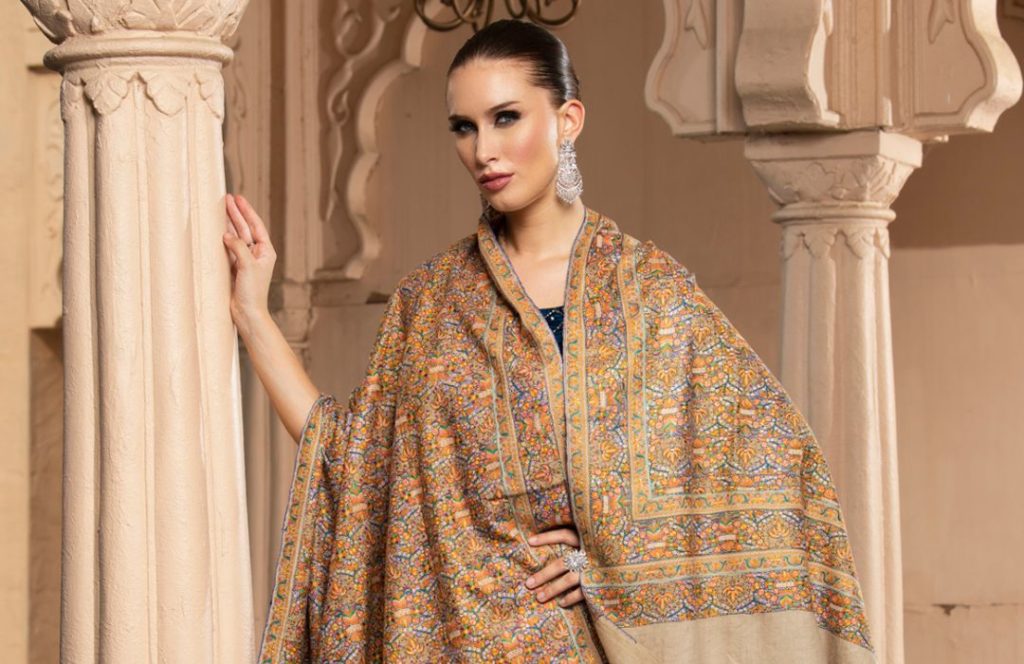
So far, we've explored the intricate world of 100% Pashmina, delving into its rich history, meticulous production process, and the unparalleled qualities that set it apart from other fabrics. From the Changthangi goats in the high altitudes of Ladakh to the skilled artisans who transform their wool into luxurious shawls and garments, every step in the creation of Pashmina comes from tradition and craftsmanship. We discussed the softness, fineness, and warmth of Pashmina fibers, which offer a tactile experience unmatched by wool, silk, or synthetic materials.
No one can overstate Pashmina's economic and cultural importance. It supports the livelihoods of herders and artisans, sustaining entire communities in remote regions. Moreover, it holds a special place in Kashmiri and Ladakhi culture, symbolizing status, prestige, and heritage. The industry's impact extends beyond local economies, contributing to global fashion trends and eco-friendly practices.
Understanding the characteristics of 100% Pashmina and the craftsmanship involved helps us appreciate its true value. Unlike synthetic fibers, which can be harsh and environmentally damaging, Pashmina offers a sustainable, luxurious alternative that is both warm and breathable. Its timeless appeal and durability make it a worthy investment, not just as a fashion statement but as a piece of cultural heritage.
In conclusion, 100% Pashmina is a testament to human ingenuity, tradition, and sustainable practices. By supporting authentic Pashmina products, you contribute to the preservation of ancient craftsmanship and the well-being of the communities that depend on this remarkable industry. We encourage you to seek out certified Pashmina, appreciate its unique qualities, and share the stories of the artisans who bring this extraordinary textile to life.
Also read: The Future of Cashmere: Predictions and Projections for 2024